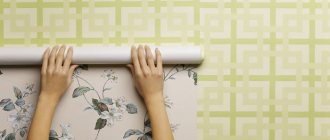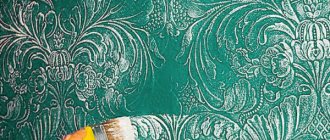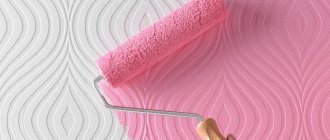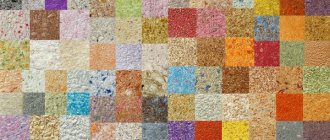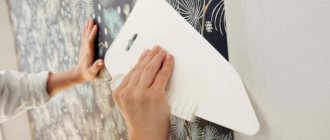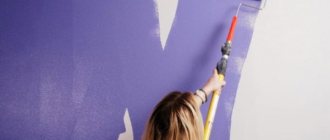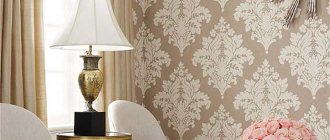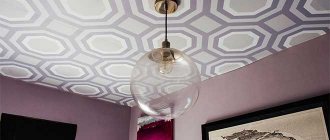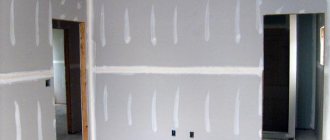Very often, in old buildings, the walls in apartments are decorated with oil paint. And if repairs are foreseen, then wallpapering such an oil-based finish is quite problematic.
The level of adhesion will be low because the paints do not bond well with other materials.
So is it still possible to somehow apply wallpaper to a base with oil paint? There are several options with which you can solve this problem and wallpapering will be done efficiently.
Features of oil-based paint
Today, such coloring agents are used quite rarely, compared to past years.
They have been replaced by modern compositions - acrylic-based paints, oil-based, latex and water-based paints. And in an oil product, the base is natural or artificial drying oil.
They serve for a long time, have a high level of strength, and can be easily painted in any color. Gluing canvases onto a surface that has a layer of oil paint on it is not a good choice.
Every professional will point out that this is not the technology, so various problems will arise during the work. Such as:
- no normal grip;
- high probability of peeling of the canvases along with a layer of oil-based paints and varnishes;
- Stains may appear on the wallpaper after gluing it, especially if paper wallpaper was used.
In this case, it turns out that it is best to spend a certain amount of time, but remove the entire layer of paint and then stick the canvas.
But in fact, there is an option in which the wallpaper can be glued to the wall with oil paint.
If you properly prepare the surface, the result will be good.
Additional Tips
To get a good result, it doesn’t hurt to listen to the following recommendations from experts:
- to ensure high-quality fixation of oil-based paint on the wall and increase the adhesion of wallpaper to it, it is better to use special ready-made primers to increase adhesion;
- if the worn-out coating has only faded and does not have large cracks, chips or obvious defects, then the puttying step can be skipped: sand the surface well enough and apply a mixture of primer and PVA onto it so that the glued wallpaper does not come off later;
- when, after a day of preparatory work, pieces of paint still peel off in some places, it is better to remove it completely, since in this case it is unlikely to be able to ensure good adhesion to the wallpaper;
- Another trick that will make preparation easier and ensure a good result is to buy non-woven or vinyl wallpaper with a relief surface: the density of the material and the convexity of the pattern will hide unevenness and minor defects.
Experienced workers recommend removing the paint before wallpapering the wall completely, however, what to do if this is not possible? How to glue wallpaper with oil paint when time is running out and you don’t want to waste effort on removing the old coating?
The answer is simple: to do this, it is enough to carefully prepare the walls, ensuring their future strong adhesion to the new material. By shortening the time and reducing labor intensity in this way, you will get the result no worse than when completely removing the old paint. For those who have not yet decided on a new wall covering and are considering other materials, we recommend reading the article about whether acrylic paint will work on oil paint.
How to determine the type of coating
First of all, you need to find out exactly what kind of coating is applied to the wall.
Here are some features of various means:
- If the surface does not shine, there is a silkiness and a matte tint, then it is a water-based
- If you run your hand along the wall and a white mark remains on it, then it’s definitely whitewash. It will not be possible to glue the canvas onto such a base; the lime will need to be completely removed. If you do not remove it, then after applying glue under the wallpaper, the entire layer of whitewash will fall behind.
- If the wall is smooth but shiny, and if you run your hand, a chill will pass - this means that the wall is covered with oil paint or enamel. It does not crumble, does not fade and has a long service life.
Preparatory work
Before gluing, you need to check whether you have everything for this and start preparing the room for the changes.
The following tools will be required:
- putty knife;
- fine “skin”;
- roller;
- wide brush;
- stationery knife for cutting cloth.
First you need to determine what paint the walls in the room are painted with. Acrylic - has a moisture-repellent effect, fits well, penetrates into porous surfaces. Oil paint has a specific smell, is applied in a thick layer, and after drying forms a “protective layer.”
To understand the type of paint, just peel off the coating with a knife or spatula. Oil will come off in pieces, acrylic will come off as shavings. The enamel chips with even sharp edges.
After this, the walls must be washed and degreased, and also checked for the presence of fungus. If there is one, treat everything with an antifungal agent and let it dry thoroughly.
If the paint comes off in the area where the fungus was found, removing the coating will be necessary. The fact is that the fungus, despite treatment with a special agent, will most likely remain. Therefore, some time after pasting, it will manifest itself again.
Old coating layer
Before preparing the wall, you need to take a good look at it. There may be a crack or spots of putty somewhere. These defects must be removed, otherwise, in the places where they are located, the wallpaper may tear or stick poorly.
With the old coating you need to do the following:
- All parts of the coating that do not adhere well must be removed (if you need to remove a lot of coating, then it is better to remove it completely).
- Remove the baseboard and remove the nails.
- If there are elements that stick out, then they need to be removed.
You can remove the old coating using a metal spatula, knife or other suitable element.
Tips for wallpapering
Using a sufficient amount of the composition will help reduce the risk of the canvas coming off. If in doubt, it is better to coat both surfaces to be joined with glue, which will help strengthen adhesion. You cannot open the doors in the room, open the windows, or allow drafts to appear during the day - this will dry out faster. Working in high humidity indoors, at temperatures below +15 and above +26-27 degrees, will lead to a lower quality result.
Professionals usually completely remove paint from the walls. At home, you can carry out the work using a simplified method if you try and thoroughly prepare the walls. Then the wallpaper will last a long time and reliably.
Sanding the surface
Gluing the finishing layer is allowed only after the wall has been fully prepared with an oil coating. This is necessary to increase the level of adhesion of the oil material.
Such work will turn a smooth base into a surface with roughness. To do this you need to purchase sandpaper.
They pass it over the entire surface on which the canvases will be glued. After sanding the base, the wall is puttied with a mixture containing gypsum. This is done only in those areas where the paint has been removed.
Use a spatula to level the surface, then sand the wall with putty again and proceed to applying a primer.
What are the walls painted with?
In order to answer the question of whether it is possible to hang wallpaper over paint, you first need to understand what type of paint is on the walls:
- Acrylic paints and varnishes are a mass that does not have a characteristic pungent aroma . The finish created by this composition is distinguished by excellent water-repellent characteristics, perfectly covers the surface, absorbing into its top layer, thereby forming a durable, wear-resistant coating. In order to identify such a coating, try to remove part of the paint with a spatula on one section. It is very difficult to remove an acrylic helmet in this way; it can only be scraped off;
- Oil paint is a finishing mass with a bright and pungent odor . This coating perfectly resists moisture, and after hardening it turns into a fairly dense protective layer. In order to identify such a finish, it is also enough to try to remove the material in a small area with a spatula. The oil finish will then fall off in chunks.
How to choose the right glue
In order for the wallpaper to stick well and reliably to the wall, it is important to buy high-quality glue.
It is best to choose a product that is suitable for heavy materials. If the material is light, then glue for vinyl or non-woven wallpaper is suitable. Moment extra, Cleo vinyl, Methylane vinyl premium adhesives are perfect; Ekon, Tekhpromsnab and Krost adhesives also have a good reputation.
If necessary, the material can be glued to a solution of PVA with water in a 1:1 ratio, or you can simply add PVA to some other composition if necessary.
Recommendations
- be sure to carefully check painted walls before purchasing building materials;
- to understand exactly how to glue on painted walls, be sure to do a test by taking a piece of painted board or iron sheet and try to stick on it, the process is similar;
- if the painted walls are in poor condition, then it will be cheaper to completely get rid of the paint layer and carry out painting work than to buy new rolls of glue.
Rejoice at even the smallest successes, and then your endeavors will end with the expected result.
Base primer
Using priming work, you can increase the level of adhesion of the old coating, as well as increase its absorption. Most experts prime the walls using a solution that they prepare manually. Here's the process to get it:
- pour up to 2 liters of water into the container;
- little by little add alabaster to the water and mix well until it reaches the consistency of sour cream;
- add PVA in approximately a ratio of 1:3 to the liquid that is already in the container;
- make up to 3 layers of primer, each new layer is applied only if the previous one is completely dry.
In non-standard situations, experts recommend using the Concrete-Contact primer, which has good penetrating characteristics. First, remove all grease and dirt. Next, apply the primer mixture and wait until it dries.
Next, apply the primer again, dry the wall, and then you can start gluing the wallpaper.
Wallpaper
0 votes
+
Vote for!
—
Vote against!
The decision to carry out repairs does not come immediately. However, even then we try to delay this process until the last moment, when the finish of all surfaces slowly begins to fade, and in some places even fall off. Therefore, to refresh your apartment or house, it is often enough to carry out a quick renovation. And here a serious question arises: how to decorate the rooms in your house. Wallpaper is becoming increasingly popular at the moment as an inexpensive and most effective way to decorate ceilings and walls. But what to do if there is old paint left on the walls, applied a long time ago, and how to hang wallpaper over the paint. This is possible subject to certain mandatory conditions.
Determining the type of paint
To properly wallpaper, you need to first determine the type of paint that was used to paint the walls. There are several types of paints. Acrylic water-based paint has no specific odor, has water-repellent properties, fits well on walls and is absorbed into them, firmly fixed in the structure.
Oil paint has a certain smell, perfectly repels moisture and forms a “protective layer” on the surface after drying. To understand whether you can stick wallpaper onto paint and how to do it correctly, try removing some of the paint from the wall with a spatula: oil paint will fall off in pieces, while acrylic paint, on the contrary, holds tightly and is removed only in small parts.
Before painting
Old paint on the walls gives owners a lot of not very pleasant moments, such as bald spots and cracks that appear when the paint material partially peels off along with the plaster, and all sorts of unevenness from the sagging that remains from old random brush strokes, or simply the color of the oil paint, which pretty tired of it. And if the walls of the kitchen are painted, then to these troubles it is worth adding the old rancid smell that has ingrained into them.
Wallpaper should not be glued to moldy or damp walls. It is absolutely not enough to treat these areas with an antifungal drug and simply dry them. It is recommended to eliminate the cause that causes mold and dampness. The simplest remedy is to attach a piece of roll insulation to the wall, and then stick a plastic mesh on it, plaster it with a layer of dry mixture, or simply cover it with a sheet of drywall.
Wallpapering: general recommendations
When choosing wallpaper, you should take into account that if there is a drawing or pattern on it, then the owners will have to join it in such a way as not to disrupt the integrity of the pattern. Always buy one more roll. Before gluing wallpaper onto paint, it is recommended to carefully read the instructions for making the adhesive and follow its instructions strictly. You cannot use glue that is not intended for the selected type of wallpaper, for example, bone glue.
It is customary to glue wallpaper starting from the window. It is better to carry out such work together: in this case, one person will glue the upper part, and the second will glue the lower part. Having cut a strip of the required length from the roll, you need to lay it with the wrong side up on the floor. Use a brush to apply the glue, spreading it evenly over the entire surface of the wallpaper, and then lift it off the floor, folding the ends of the strip together.
Paste wallpaper onto paint, drywall or old wallpaper from the top. The strip should be aligned with the ceiling and placed tightly against the wall. Using movements that resemble the shape of a Christmas tree, you should press the wallpaper tightly against the wall from the middle of the strip - to the edges and down. It is better to do this with a rag or roller. You can also use a rag to remove excess glue that has come out around the edges.
The next strip needs to be glued in the same way, but taking into account the wallpaper image. The strips should be placed end to end, but not overlapping. You need to go over the joints again with a rag to fix them well. Switches and sockets must be covered with wallpaper, and immediately cut with a construction knife or blade crosswise in two lines. Then the excess part should be carefully trimmed around the perimeter of the switch or socket.
Under window openings and above the door, wallpaper is glued after sticking all the solid strips. Is it necessary to glue wallpaper on the walls where the furniture set will be placed? You should do so at your own discretion. If you plan to rearrange the furniture in the future, then, of course, it’s worth hanging wallpaper. It is strictly forbidden to use hot glue, because its consistency becomes liquid, which is the reason that the adhesive composition begins to protrude beyond the edges of the canvas, staining the front side of the wallpaper.
We glue wallpaper with water-based paint
To hang wallpaper on water-based paint, you must first prepare the walls, otherwise the canvas may quickly fall away from the surface. First of all, you need to neutralize the old layer of paint. To do this, it is customary to prepare a mixture of primer and solvent in a 1:1 ratio and apply this composition to the surface to be treated. The solvent included in the mixture partially corrodes the old coating, allowing the primer to penetrate the wall structure and provide a reliable connection to the new finish.
After this, the wall should dry, and only then can a layer of clean primer be applied on top. This method allows you to obtain a rough surface, which is necessary for good adhesion of the wallpaper to the surface. After drying, the wallpaper is directly applied to the paint. For these purposes, it is necessary to prepare a special composition, which consists of equal parts of wallpaper glue and PVA. It should be applied to wallpaper and to a primed wall.
Wallpaper sticker with oil paint
Oil paint is a very tenacious substance that can stick to walls for years. But in this case, the whole difficulty lies in the fact that the layers of paint have a very smooth surface, which makes it difficult to achieve good adhesion of the wallpaper to the wall. Based on this, when planning to stick wallpaper on oil paint, you also need to do preparatory work. There are two methods for preparing walls covered with oil paint.
The first of them is as follows. To obtain a surface suitable for pasting, you should treat the walls with coarse sandpaper and apply a mixture of primer and PVA glue in a 1 to 1 ratio to the sanded surface.
The second method is this. Using a spatula, every twenty centimeters, it is customary to remove a layer of paint, which is 5 centimeters wide, in horizontal stripes, and then apply putty to the treated areas to level them with the rest of the surface. These strips are designed to ensure good adhesion of the panel to the walls. This method of wallpapering with oil paint is considered less effective, but it also has a right to exist.
There is no need to repeat how to glue wallpaper onto paint - the sequence of actions is similar. The only difference is the composition of the adhesive solution - when gluing wallpaper on oil-based paints, you should use 2 times more wallpaper glue than PVA glue. By following these steps, you will get good results. The wallpaper will hold tightly, delighting the owners with its appearance.
Wallpaper sticker on whitewash and enamel
You already understand that water-based paint can be washed with warm water and a cloth. But there are other finishing materials. For example, the situation is more complicated with whitewashing, because this material is not able to withstand any loads. If you plan to put wallpaper on whitewashed walls, remember that the whitewash will have to be removed completely. To do this, soak it a little with soapy water and then remove it with a spatula. Wash off any remaining residue with warm water using a sponge. You cannot leave even the slightest area that has been whitewashed.
It is very easy to check the opposite. It is enough to run your palm along the wall with your palm and analyze the result. If there is even a little chalk left on your hand, you will have to wash the wall again and remove the last traces of whitewash. Without doing this, you don’t have to take on wallpapering - all your efforts will be in vain. Eventually, the wallpaper will come off in the places where the paint remains, and bubbles will appear if moisture appears there.
The second option for preparing whitewashed walls for wallpapering is to treat the surface twice with a primer, which has deep penetration, and dry each layer well. After this, you should prepare glue diluted with water. The water content should be 20%. It is customary to treat the walls with this composition, then you need to wait for the substance to dry completely and you can glue the wallpaper.
But if the surface was painted with enamel, then in this case it will be possible to glue the wallpaper directly to the walls. But you must first make sure how firmly the paint adheres to the wall. You need to remove the enamel in those places where the substance falls off on its own. Be sure to go over the entire surface with coarse sandpaper and remove dust from the wall. For greater strength, it is recommended to pre-glue the surface with a special impregnation for walls.
Pasting concrete walls
Since we are talking about how to glue wallpaper onto paint, and we are talking about non-standard surfaces, we should definitely mention an ordinary concrete wall, which can serve as a basis for wallpaper. Many developers are interested in how to glue wallpaper to concrete. Of course, it seems unnecessary to carry out preparatory activities.
However, it should be noted that wallpaper, especially expensive natural and fabric wallpaper, are very demanding on the evenness of the walls, and concrete walls are a surface that is completely covered with tubercles and potholes. Therefore, in this case there can be no talk about the quality of work.
To prepare a concrete surface for pasting, it is customary to level it with bricks in order to smooth out the main irregularities. After this, it’s time to clean the base with sandpaper and remove dirt and dust. After drying, the walls must be plastered and primed with a high-quality composition that meets the necessary technical parameters.
The primer should have good moisture resistance properties, provide protection against fungus and mold and, of course, firmly bond the wallpaper to the surface. Wallpaper glue performs approximately the same functions. Wallpapering concrete walls can only be done in rooms with low humidity and a complete absence of drafts.
Pasting wallpaper onto paint without preparing walls
To find out whether it is possible to hang wallpaper over paint without preparing the walls, first check the walls for strength. To do this, you will need a simple construction tape; you need to attach it to a wall that is painted, after which it should be torn off with a sharp movement from the wall. If the paint material remains in place and no changes have occurred, then we can assume that the paint has passed the test.
But when there are paint particles left on the inside of the tape, this coating will have to be completely cleaned off. This will take a long time, so you need to be patient. In this case, clean the paint with a special metal brush, which is mounted on a drill, or with a spatula. Solvents are very rarely used due to the harmful odor emitted by the chemical.
Wallpaper can be glued to a wall that has passed the tape test without pre-treatment of the surface, because the paint has created a durable, smooth and fairly even surface. Sometimes, to achieve a rough surface, craftsmen process the paint with sandpaper. Finally, remember that you should not stick light thin wallpaper over dark paint, because the dark color will be visible through the new finish, completely ruining the appearance of the room.
Now you have figured out how to apply wallpaper to paint, and are ready to put your knowledge into practice. Each room in your home should have its own personality and its own unique look, so you should be smart about choosing wallpaper and applying it later. Proper preparation of walls for subsequent wallpapering is a troublesome and rather expensive procedure, but extremely desirable. You need to approach the work with all responsibility, and then the residents of your home will be able to enjoy the results. The updated design will last a long time.
Pasting canvases
Mix the glue according to the instructions and begin wallpapering. You cannot change the proportions of glue and water, as this may harm the normal adhesion of the materials.
The glue is applied to the wallpaper with a brush or roller - this method is used for pasting paper wallpaper.
If the wallpaper is of a different quality, then the adhesive composition must be applied to the surface and to the wallpaper. For non-woven wallpaper and glass wallpaper, it is enough to apply glue only to the wall.
Start gluing the canvas from the corner closest to the window. Next, the wallpaper needs to be perfectly aligned.
If someone is doing this kind of work for the first time, then it is better to draw a line of wallpaper on the wall before gluing it so that there are no mistakes during the process. To remove air bubbles, smooth the wallpaper with a rag or spatula.
Next, they glue the next piece of material, joining it with the first one.
To make the joints look aesthetically pleasing and neat, use a rubber spatula. Then they cover the entire room in the same way.
The top and bottom are cut with a knife under the baseboards, carefully placing a spatula. This is necessary in order not to damage the walls. Then they cut out space for sockets and switches.
Results
To summarize, it can be noted that professionals do not recommend gluing wallpaper over any paint, but there are no clear prohibitions against this. If such a decision is nevertheless made, it is necessary to take the work very seriously and not allow the slightest mistake.
But it should be noted that even if you do everything strictly according to the instructions, there is no 100% guarantee that you will be able to hang the wallpaper successfully, you will get an ideal surface and the wallpaper will serve you for a long period of time. As for the rest, it’s up to everyone to decide individually: is it worth the risk, or spend a little more effort and time and completely clean the surface of the old paint?
Recommended Posts
Wallpaper in a modern style, Provence, loft, modern
How to glue wide non-woven wallpaper
Gluing non-woven wallpaper
Design of combined wallpaper for the hall
DIY wallpapering in corners
How to choose wallpaper for a small room
How to glue wallpaper on a concrete base
Concrete walls have pores in the form of small bowls and pits; it is not advisable to glue wallpaper onto such a base; a careful inspection will reveal poor-quality work. Therefore, the walls need to be primed and puttied. It often happens that when wallpapering, folds appear in the area of the corners, this indicates that the corner joints are uneven. To avoid such a rotation, it is necessary to remove them with plaster mortar. To do this, pour the prepared mixture into the corners and use a plastering rule to move it first to one side, then to the other. If you use plaster with a fine-grained fraction, you can do without subsequent puttying. When the solution is completely dry, you can begin the main process.
How to test paint strength
The strength of the layer is one of the conditions under which a high-quality result is obtained. Otherwise, over time, there is a high probability that the material will simply fall off the base, even if it is glued well.
As in other cases, verification is performed in two simple ways.
- Take wallpaper glue and cover small areas of the walls with it. Fiberglass also allows such processing.
You need to wait until the composition dries completely. The adhesive layer is removed by prying the base with a spatula. The old finish definitely needs to be removed if it comes off along with the rest of the parts.
- A piece of ordinary tape is pressed tightly against the wall surface.
A sharp movement is made to tear off the tape. There is a small amount of paint on the surface, which means their quality is unsatisfactory. You can't do without cleaning the paint base.
Preparatory work is required even if the majority of checks are satisfactory. Otherwise it is more difficult to paint.
The strength of the layer is one of the conditions under which a high-quality result is obtained.
Risks of wallpapering painted walls
Paint is not always the main obstacle to wallpaper application. The finishing material lasts a long time if the approach to work was correct. But there are some nuances that cause difficulties:
- The coloring matter flakes off.
In some places, the dyes fall off, swell, and crack. It is recommended to test the entire surface for strength to avoid such problems. Other methods will also be permitted.
- Falling off of particles in the case of water-based paint.
Moisture spoils the substrate when it gets on the surface. As a result, peeling occurs and swelling appears. Testing for strength involves repeated moistening. If there are no negative consequences, feel free to move on to decorating the walls with wallpaper.
If there are serious defects, it must be cleaned completely. Only then is it allowed to glue.
If there are no negative consequences, feel free to move on to decorating the walls with wallpaper.
Paints and wallpapers lead to shorter deadlines for cosmetic repairs. The process of doing the work in this case is as simple as possible. The main thing is to take care of surface preparation. In other respects, the actions are no different from the use of similar materials.
Wallpaper selection
Among the variety of products, it is not possible to glue heavy rolls such as vinyl. You should choose only lightweight paper products, or models with a very small amount of non-woven fabric.
When the base has been cleaned to a rough finish or the remaining paint is very different in shade, a thin layer of putty is applied to avoid another color showing through.
Thin wallpaper will tightly fit the surface of the walls, making unevenness visible. The base will have to be completely leveled.
If you decide to use liquid wallpaper in the interior, you first need to paint the existing trim with white paint. Painting is necessary so that another color does not break through from below when the wallpaper solution is not completely filled.
What glue to use
The adhesive is chosen depending on the type of wallpaper. A universal adhesive mixture is produced separately, but it is not recommended to use it, as it may not have the qualities required in a particular situation.
A narrowly targeted composition is needed that will provide the required degree of adhesion and will not harm the facing material.
If you purchase self-adhesive wallpaper, you do not need to take additional glue - just gradually remove the protective film from behind and glue the canvas.
Working with a whitewashed surface
Before gluing, the walls must be treated with a primer.
In order for the work to be of high quality, it is necessary to wet the walls with water or a special solution and clean them off using a wide spatula. Of course, this is a labor-intensive process, but it is also guaranteed to work. After cleaning work, the surface must be primed with a deep-permeable compound. After the primer has dried, you can safely glue the wallpaper.
If the apartment owner wondered how to glue wallpaper directly onto whitewash, then in principle this is not a problem. To do this, you need to thoroughly saturate the walls with a deep penetration primer. To prevent the chalk from coming off during pasting, it is recommended to apply glue only to sheets of wallpaper. This option will allow only one touch to the wall; if you need to remove and re-glue, then rest assured that all the whitewash will remain on the sheet. This type of surface is unreliable, and therefore it is necessary to stick only light paper wallpaper with good throughput.
Checking the degree of adhesion
It is also important to make sure that the existing finishing layer is firmly fixed to the wall.
To test the paint, you will need a small piece of masking tape. It is necessary to attach it to the base, pressing it with your palm, smoothly draw it along its length and sharply tear it off.
Checking the grip strength
The remaining paint particles indicate that this coating is not suitable for pasting, since the canvases will not stick to it and will soon fall off.
It is prohibited to carry out finishing work if there are traces of fungus or mold until the affected area is completely cleaned and treated with antiseptics. Then complete removal of the previous layer of paint is allowed.
